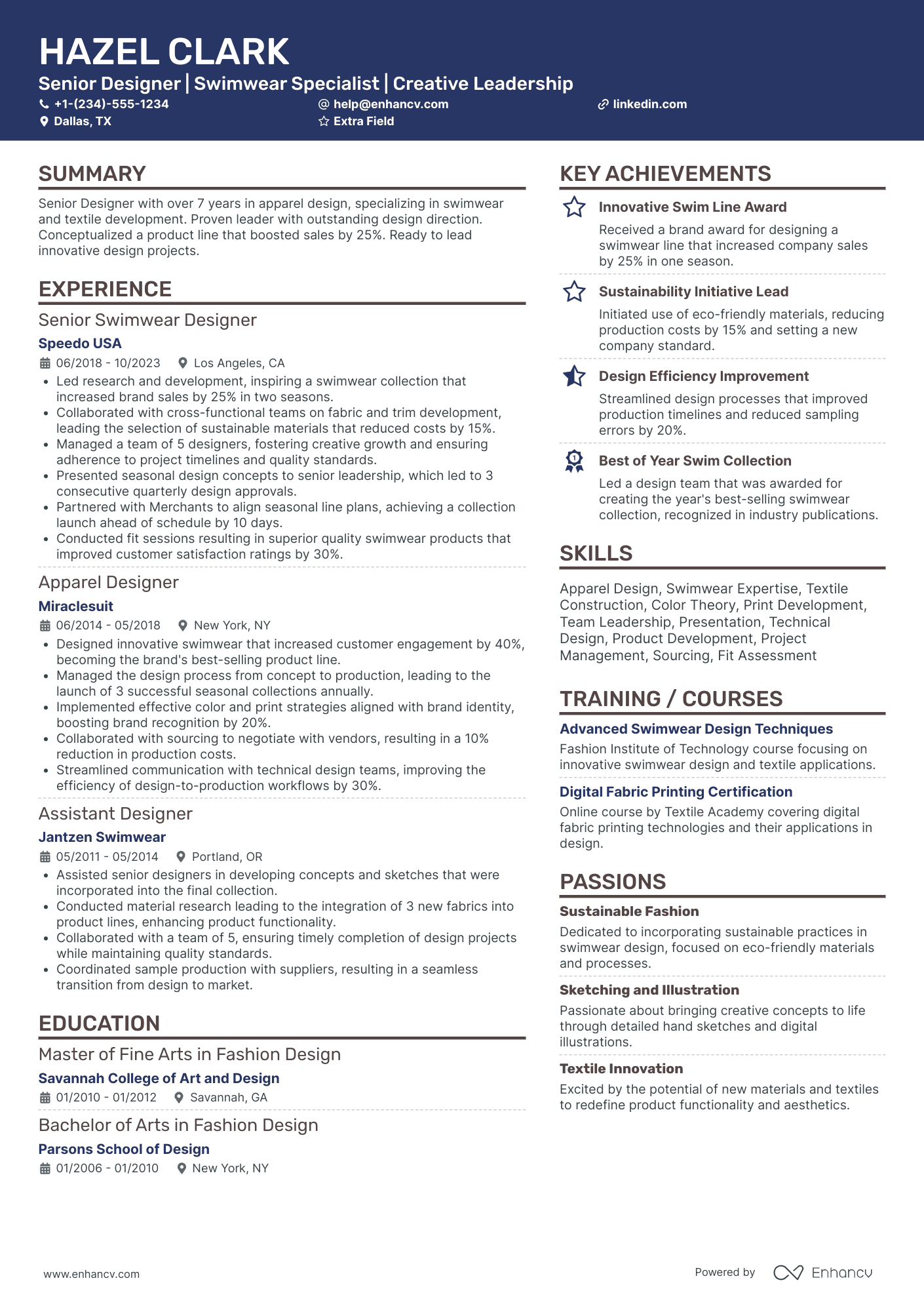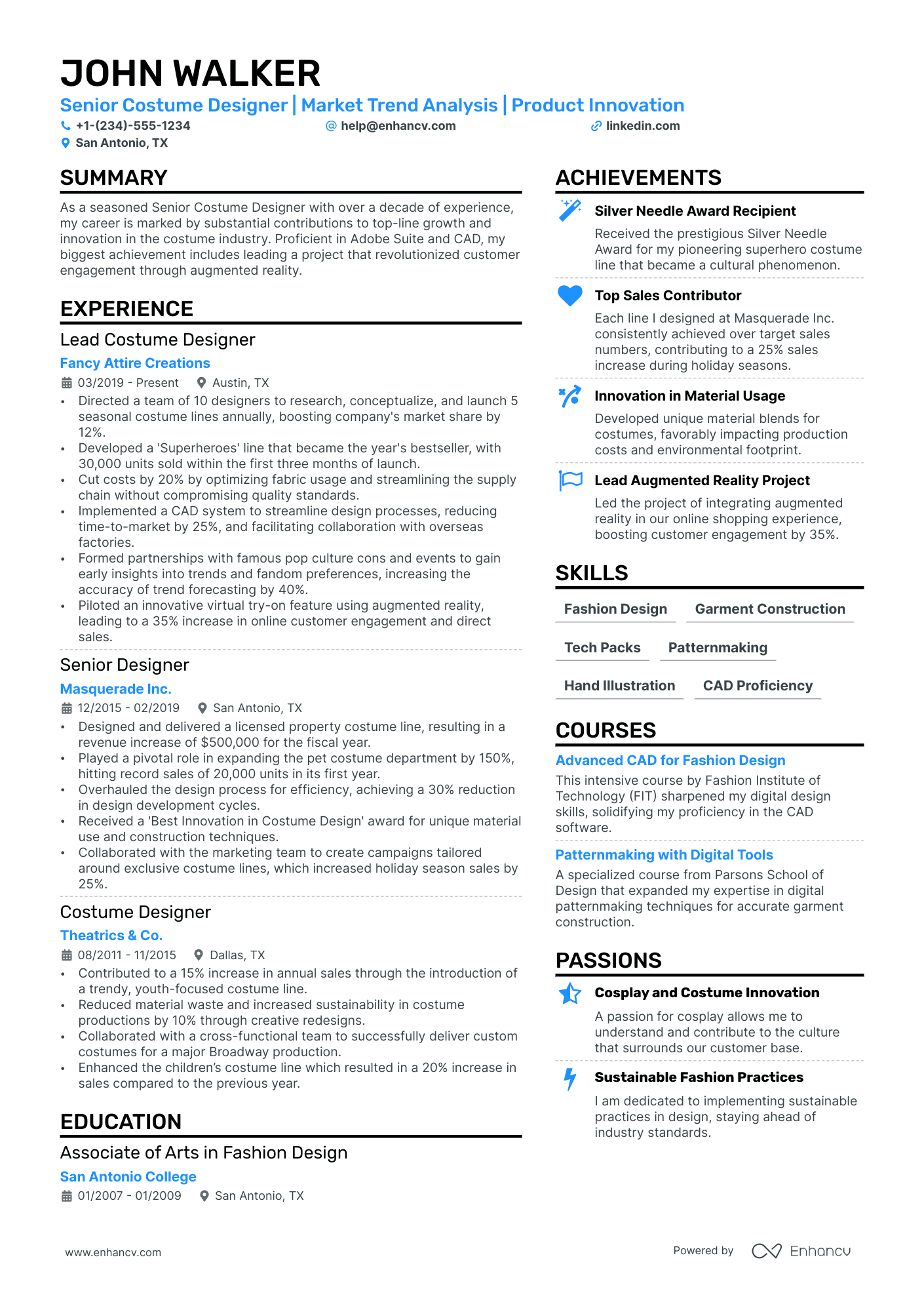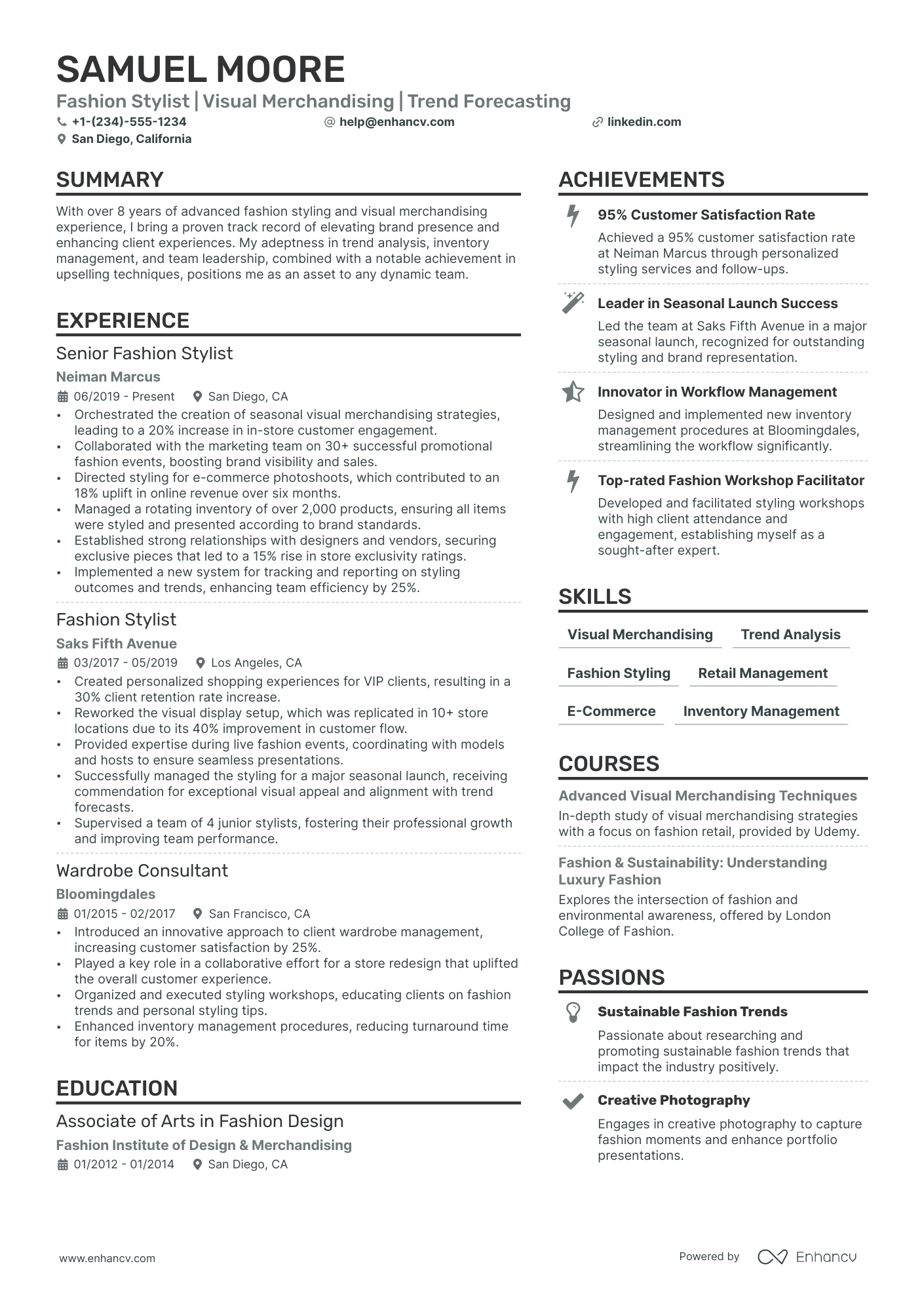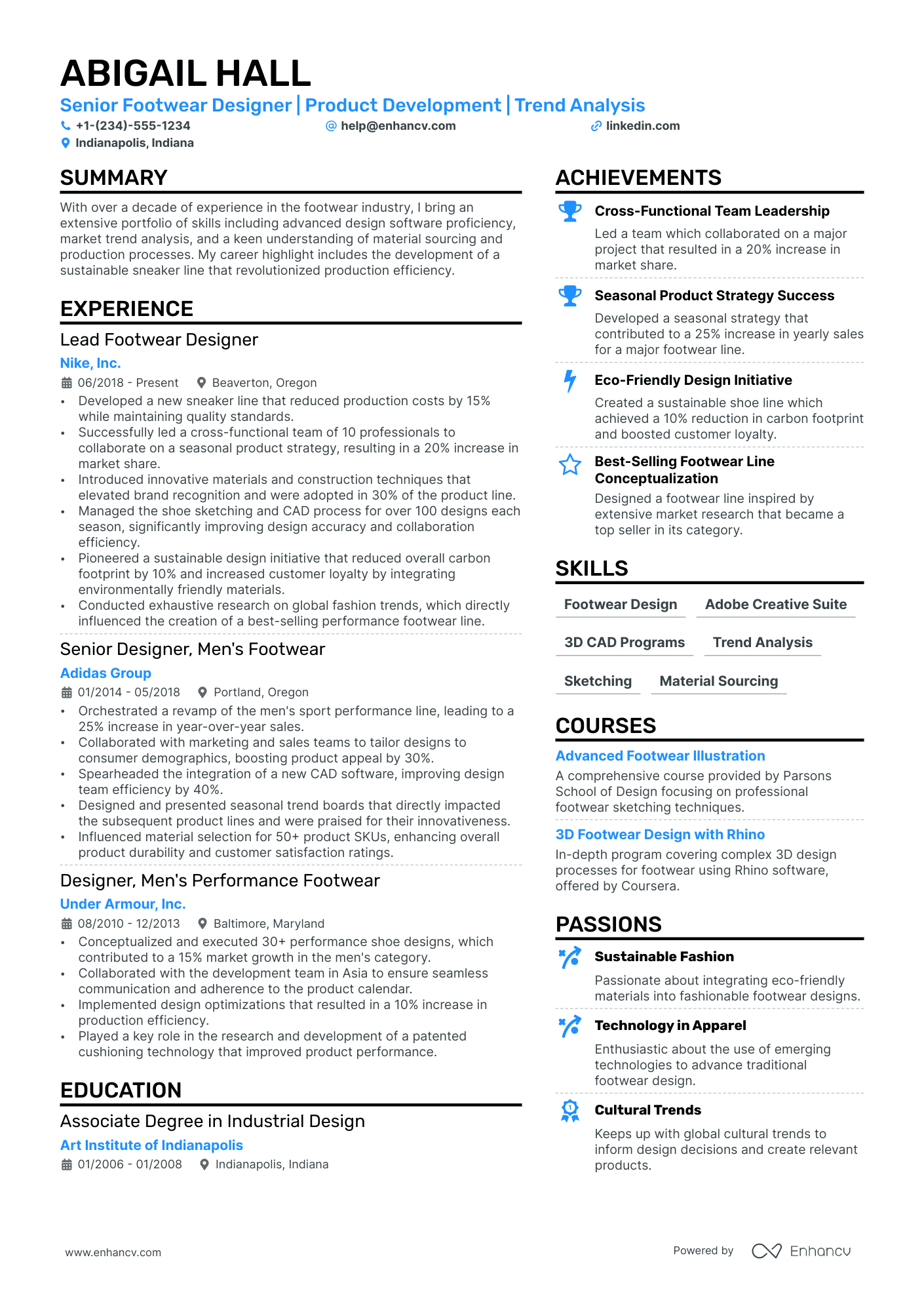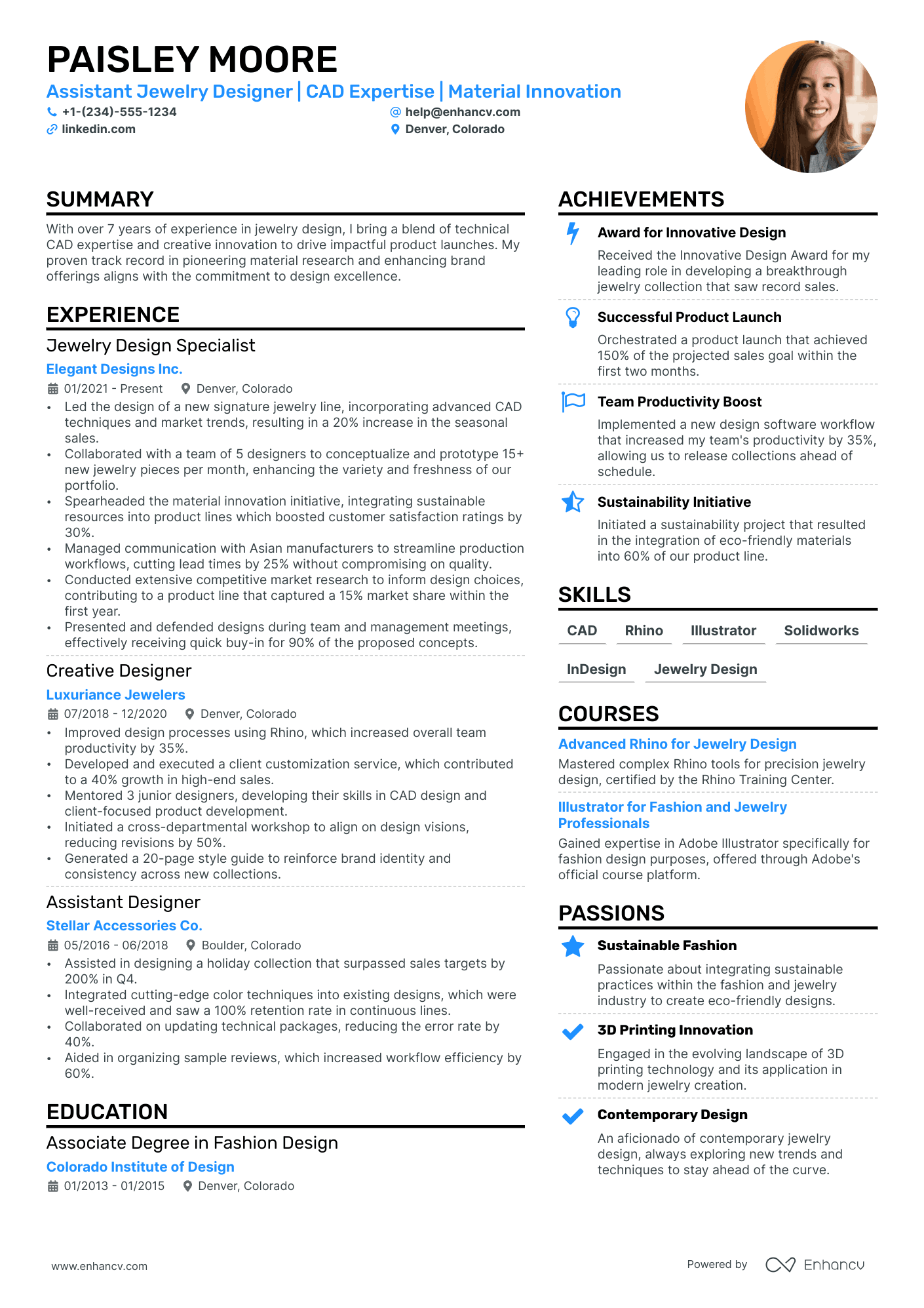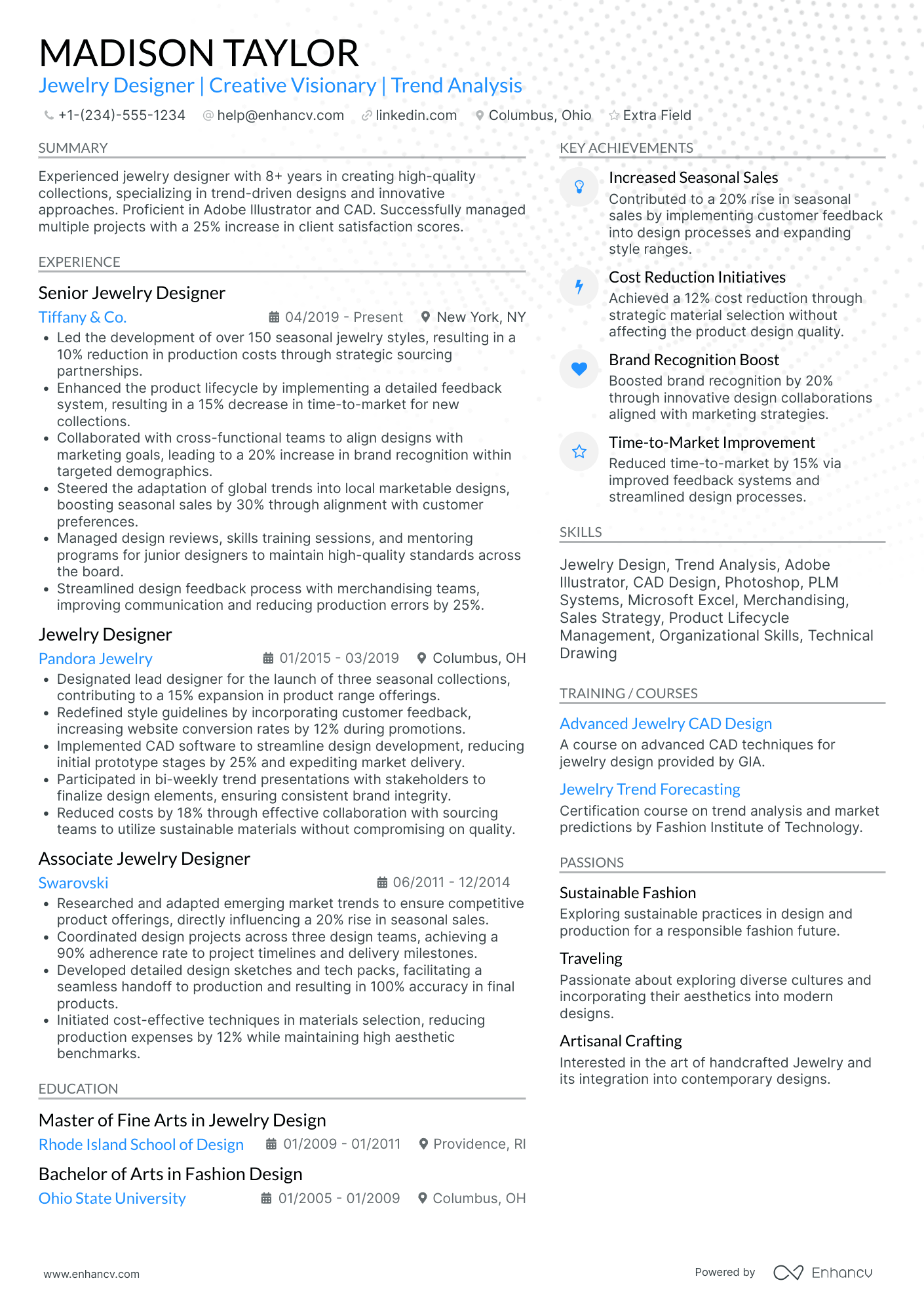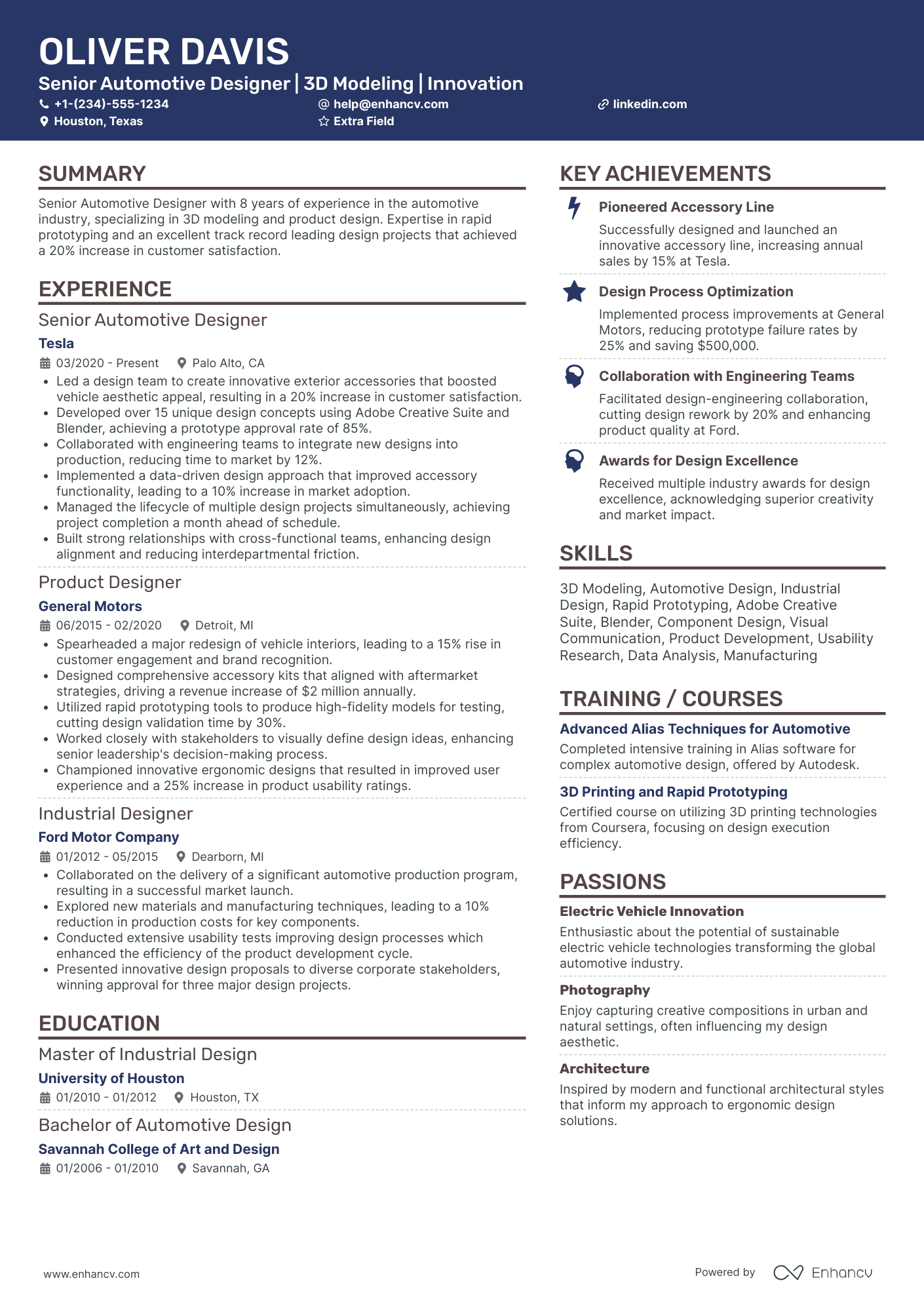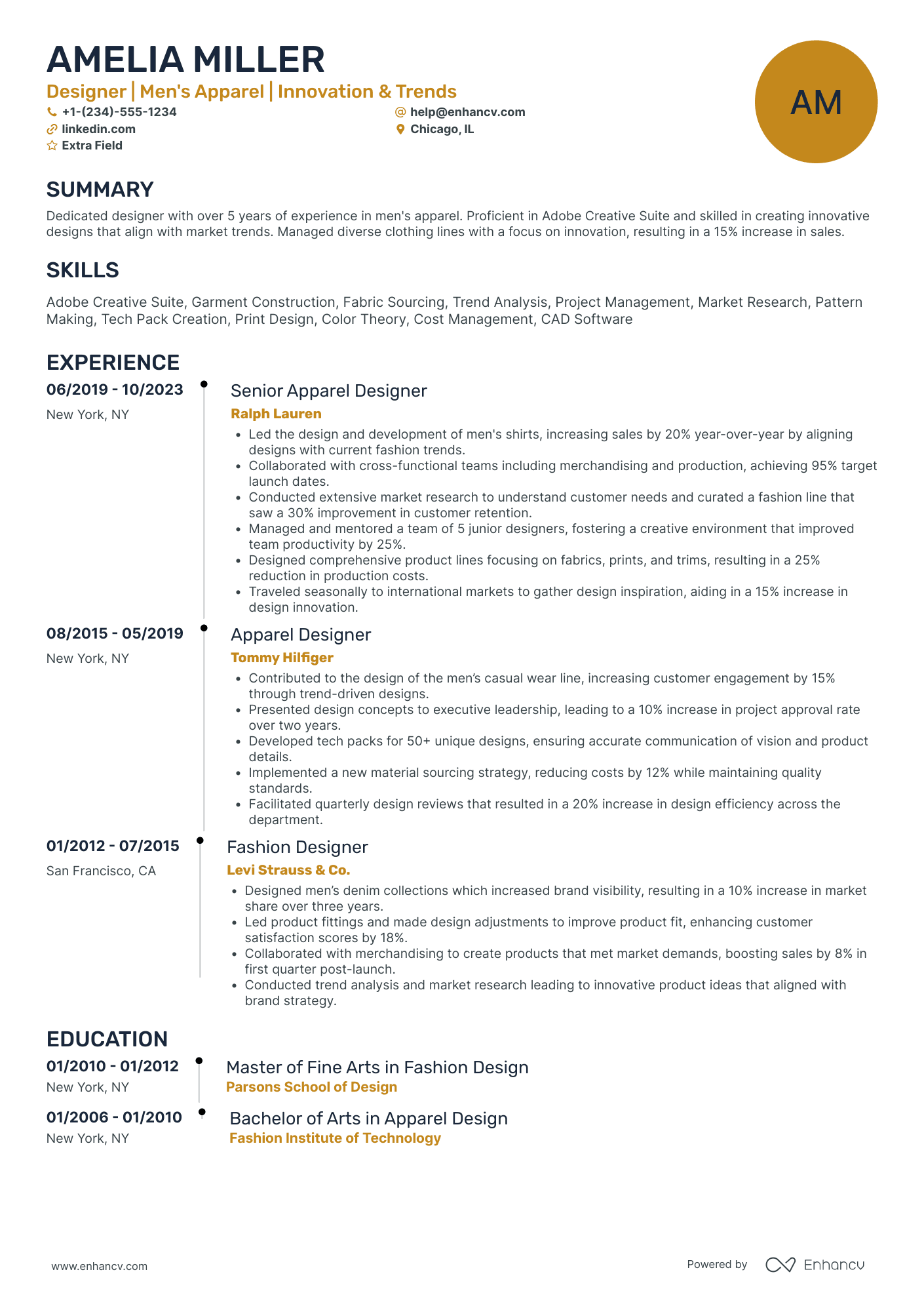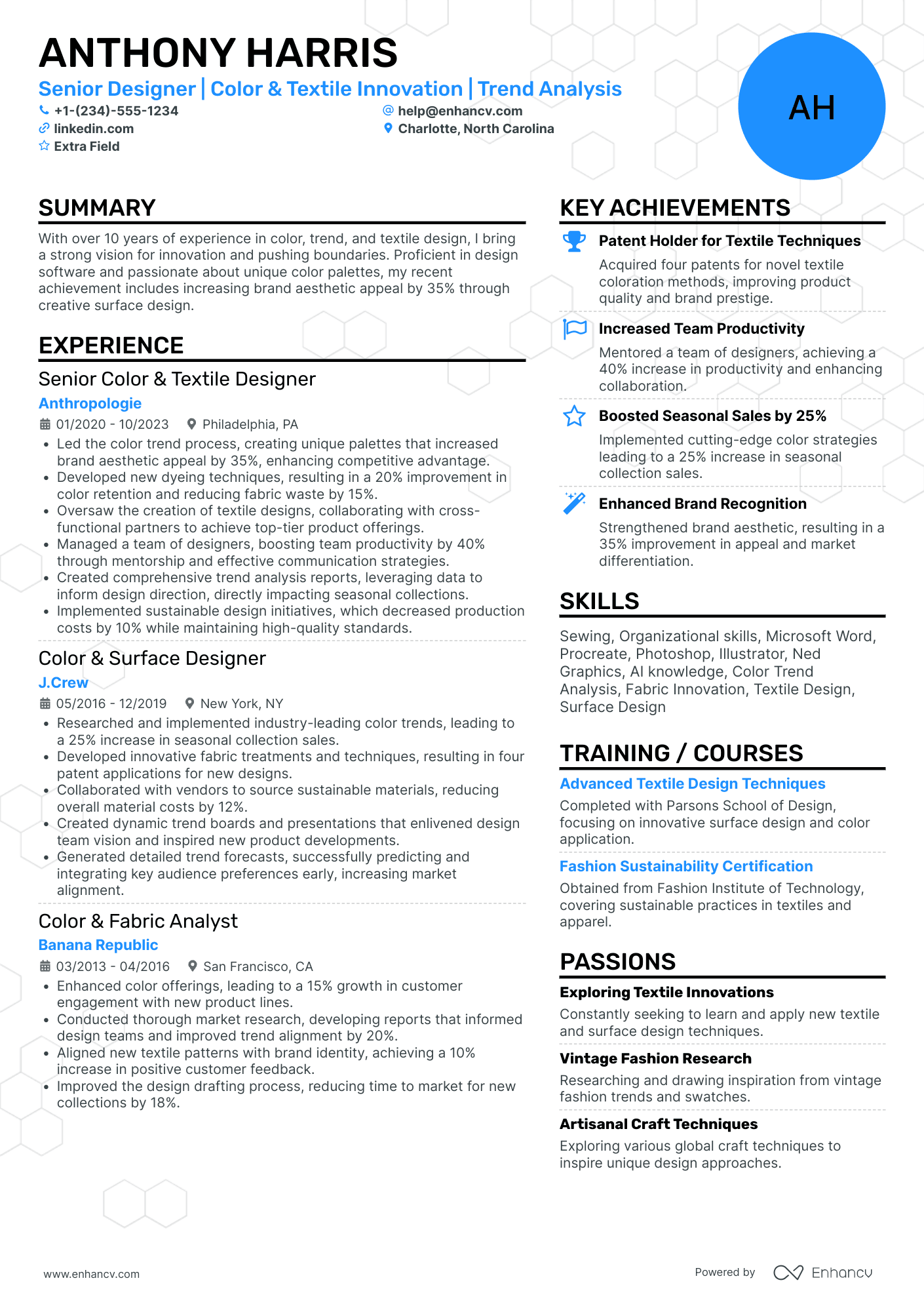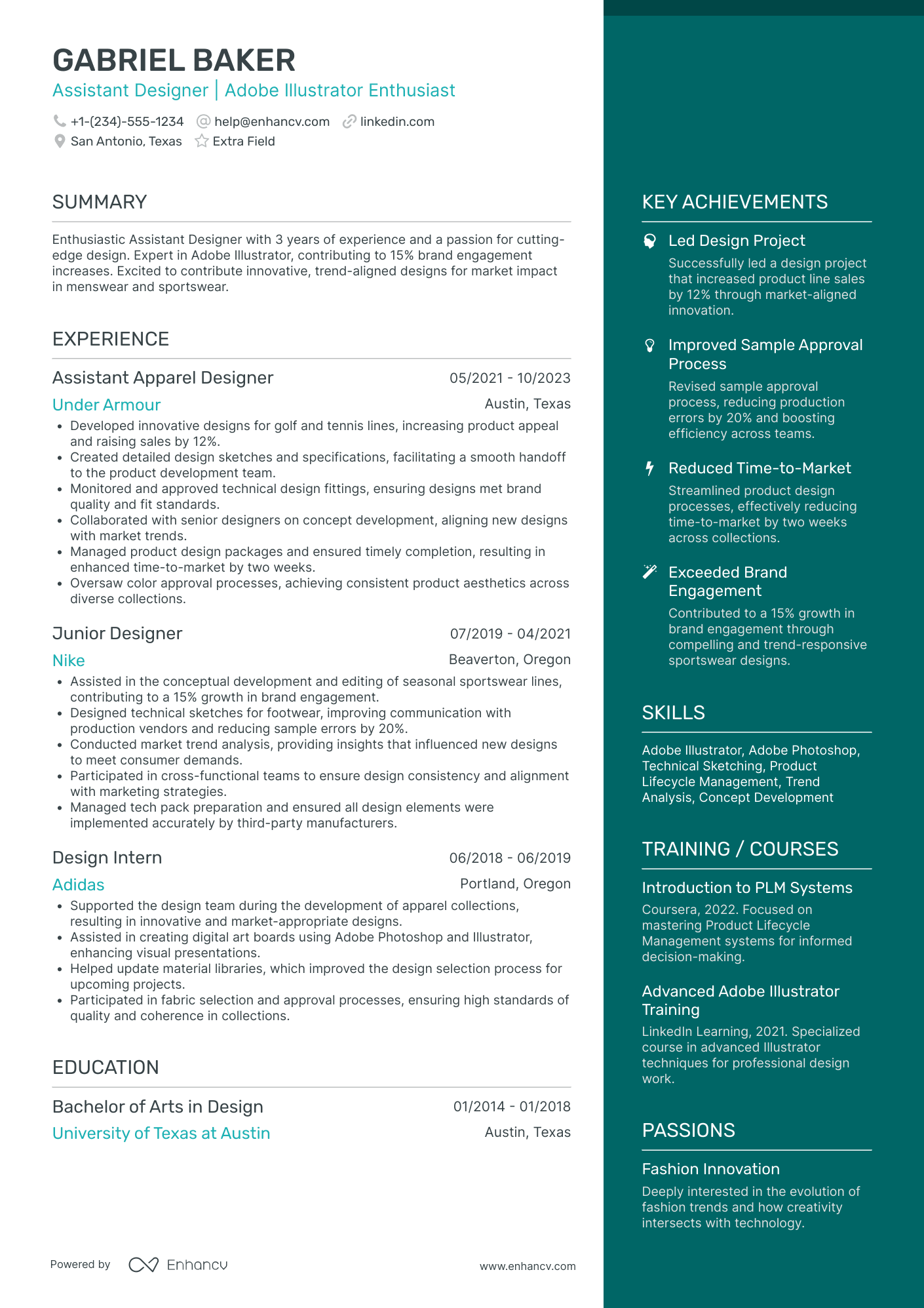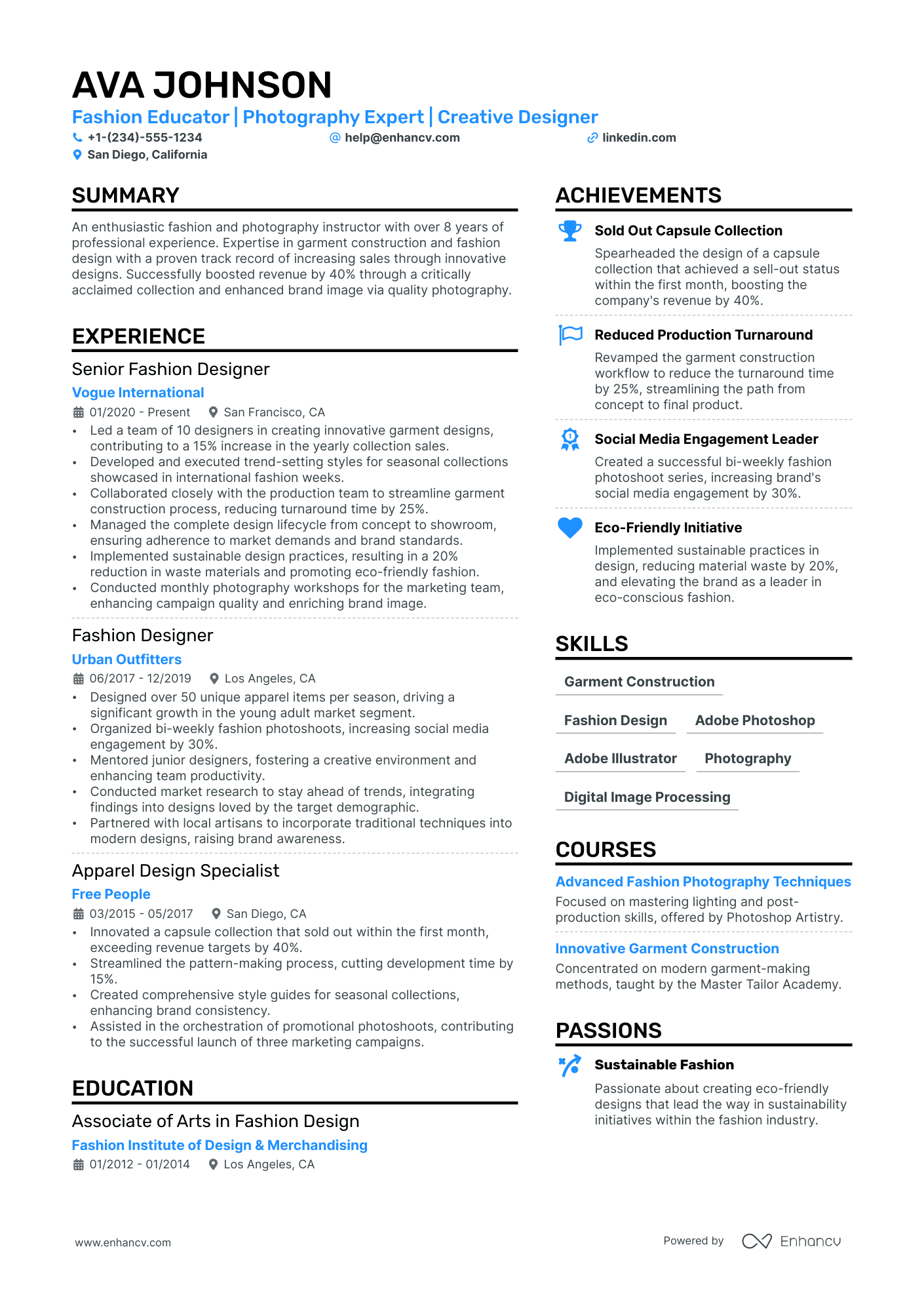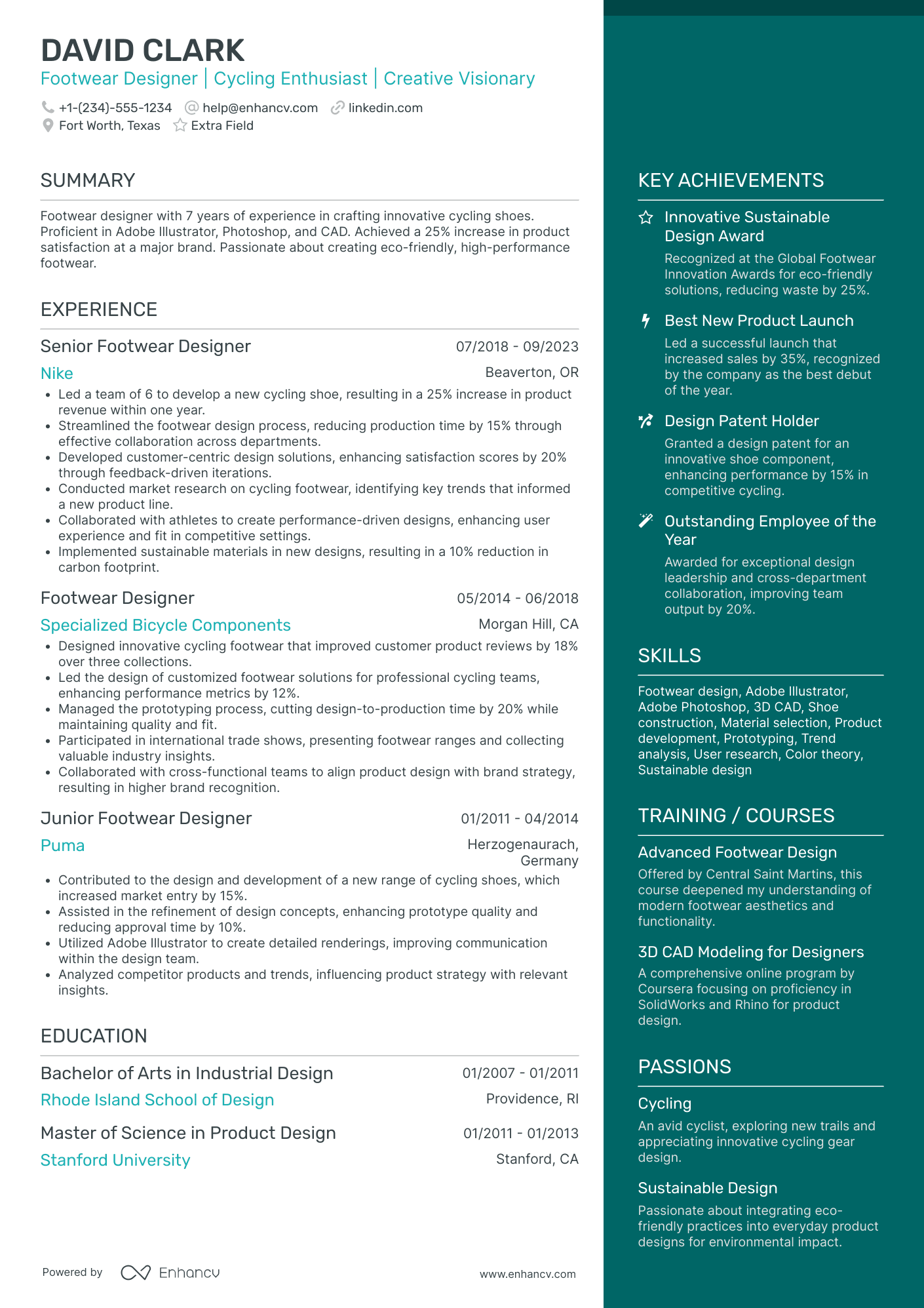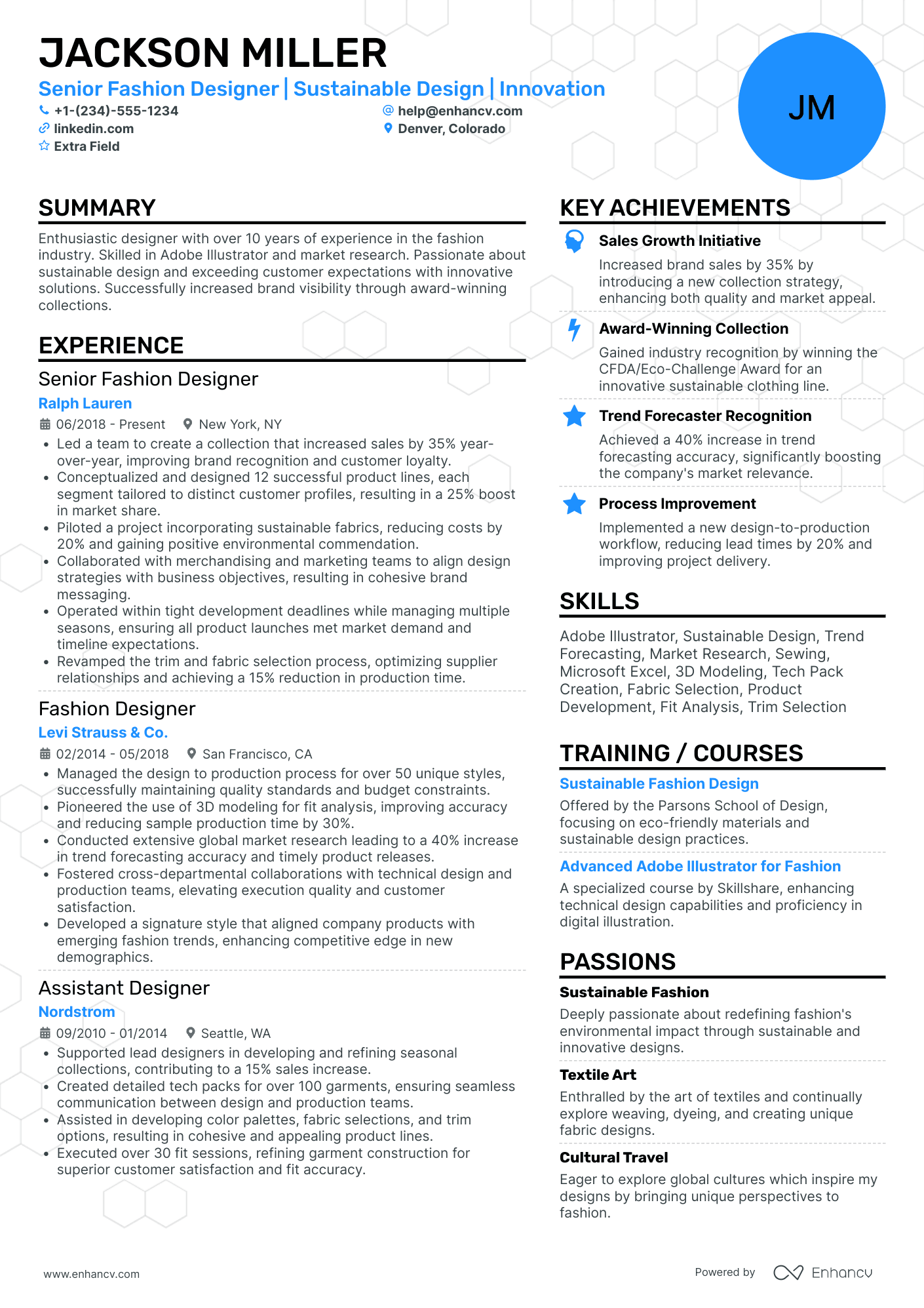It's not what you know. It's who you know.
Right? Wrong.
The fashion industry might seem like a close-knit community, but in reality, it's not. It's a global industry with hundreds of thousands of available jobs.
When a recruiter is deciding who to bring in for an interview, they're not looking for a familiar face.
They're looking at how involved a candidate has been in the design process at previous jobs.
They're seeing which product lines they've worked on. They're interested in which brands a candidate has worked for and what results has she brought to the table.
And how can a candidate best convey this? With a well-written fashion designer resume.
What You’ll Learn From This Fashion Designer Resume
- 8 examples of right and wrong fashion designer resumes
- How to choose a resume template that is both design-oriented and professional
- What a recruiter is looking for in a fashion designer resume
- Which sections a fashion designer resume should include
- How to write a compelling summary that stands out to recruiters
- The right way to list your skills, software, and experience
- Common mistakes fashion designers make when writing a resume and how to fix them
looking for design industry related resumes?
Learn How to Write a Fashion Designer Resume
fashion designers can't expect to land a job with any old resume.
The very nature of the job is design-oriented, meaning creativity is a key component.
Your design skills and sense-of-style should shine through in your resume. Unlike other industries, you shouldn't be using 12-point, Times New Roman font.
We're not saying you should use every color in the rainbow or pick a funky layout. But you should choose a resume format that is both design-oriented and professional.
As for what to write, do your research.
Read over the job description.
Pay close attention to the bullets. Do you have any similar project experience? If so, you should include it in your resume.
What are the required skills? Adobe Illustrator? Sketching? Textile engineering? Pattern making? Include all required skills you have on your resume in an easy-to-find way.
Hiring managers often have hundreds of resumes to riffle through. They should be able to see your skills and experience just by skimming it.
Here's what a recruiter is looking for in your fashion designer resume
- What makes you the best fit for the position, i.e. what is your value proposition for the company?
- Have you used CAD software on a daily basis - as well as examples of designs in your portfolio?
- Do you have experience in coordinating and executing seasonal lines and pattern productions from concept to final product?
- Have your products been featured in magazines, fashion shows, or valued highly by end consumers?
- What’s your background in terms of negotiating and contracting with fashion agencies, photographers, hair stylists and shoot producers?
"A resume is an indicator of how you think and how you present yourself and the first example of what an employer can expect of your work product."
Joyce Chang, editor-in-chief of Self.
Include these 6 Fashion Design resume sections
- Header section with contact information and link to design portfolio
- A summary section highlighting your experience and why you're interested in the position
- Experience section that details your fashion design achievements and abilities
- Skills section for industry-specific tools you've mastered
- Education section
- Industry certification section (optional)
The layout of your resume depends on your level of experience.
If you're an entry-level candidate, it's best to start with your educational experience. From there, focus on any industry certifications or skills you have.
If you've worked in the industry, focus on your previous employment experience first. Hiring managers value real-world experience over a degree you graduated with years ago.
List in reverse-chronological order, from most recent to least recent. And don't underestimate the importance of a good resume header.
How to Create the Perfect Fashion Designer Resume Header
Believe it or not, there is a wrong and right way to write a fashion designer resume header.
A header should include your name, location, title and contact information. (at the very least).
That's true for any industry.
As a fashion designer, you should also link your online portfolio. It's the best way to showcase your work and increase your chance of landing an interview.
Headers can also include your home address, LinkedIn profile, and social media handles.
Be wary of including your address though. Living in a different city or far from an office could be something a hiring manager could count against you.
And, only include your social media handles if the posts are relevant to the position.
If your Instagram is just photos of you with your friends, it's not worth mentioning. If it showcases your designs and work-related projects, by all means, add it.
Ensure your phone and email are both hyper-linked. Getting ahold of you should be a click away. You don't want to make the hiring manager work for it.
Here are some examples of right and wrong header examples.
2 fashion designer resume header examples
Without a portfolio link, a hiring manager is unlikely to bring you in for an interview.
They need to know you have the necessary skills and experience to succeed in the position.
With a portfolio link and clickable contact information, a recruiter is much more likely to reach out.
Pro tip
You want your links to be clickable, but you should also make sure they are print-friendly. Always include the full url, so that if a recruiter checks a printed version of your portfolio, they’ll still be able to examine your links.
Once you have a proper resume heading, it’s time to work on a summary or objective section.
How to Make Your Fashion Designer Summary Stand Out
Including an objective or summary on your resume is always a good idea.
It's like the written version of an elevator speech. It's your chance to grab the attention of a recruiter or hiring manager.
Which one should you include though? An objective or a summary?
Well, it depends on your level of experience.
If you are new to the industry, include an objective. Talk about what you want to achieve in your career and what impact you can make in the position.
If you have some experience under your belt, include a summary. Be as specific as possible about your previous experience and career achievements.
Writing a generic objective or summary is not going to help you stand out. Instead, focus on what makes you unique — on what sets you apart from everyone else.
- Have you worked on a line from conception to completion?
- Do you work directly with vendors?
- What software do you use to bring your sketch designs to life?
- What brands have you worked with? What type of clothing do you design?
2 senior fashion designer resume summary examples
This summary is very vague and doesn’t depict any unique skills or experience.
This summary focuses on specific fashion design experience and highlights career achievements. Here’s everything a recruiter can get from this resume:
- Years of experience;
- Specialization (women’s high-end clothing);
- Indicators that candidate’s work is quality (magazine features, top seller);
- Relevant experience for big brands;
Pro tip
When it comes to resume objectives or summaries, the more specific you can be, the better.
After you’ve finished the summary, you can start to expand upon it in the experience section.
Fashion Designer Resume Experience - How to List It the Right Way
Listing job experience can be tricky. Often, you'll have to tweak it depending on the position or company you're applying for.
Always refer to the job posting and make a note of the primary job responsibilities and skills. They're often listed in order of importance in bulleted points.
The recruiters want to see if you have similar job experience. Going over job boards, you’ll start to observe a pattern:
- Relevant experience in manual drawing and sketching or/and proficiency in CAD software;
- Experience working with a wide variety of fabrics;
- Extensive design theory mastery: color wheel familiarity, design conceptualization and implementation;
- Merchandising;
- Excellent sense of style;
- Knowledge of past and current fashion trends;
- Consumer behavior and buying habits;
Now, to make the most of the experience section of your resume, highlight key achievements. Use as many relevant numerical examples as possible.
Start each sentence with power verbs to focus on your strengths.
You can say "created ready-to-sell goods for boutique on eBay" and sound generic and unimpressive.
Or go with "conceptualized from start to finish a new clothing line for a men’s boutique on Amazon, that drove $400K in monthly sales".
Let’s do that a few more times.
Fashion designer resume experience examples
- •Created conceptual sketches
- •Selected fabrics and fits for fashion lines
- •Helped with design process from start to finish
- •Worked with team members to meet deadlines
These bullets are too generic. They don’t mention any industry-specific tools or software.
Consider including something like this instead for your experience section.
- •Sketched style specifics & details for five product lines, following a sku plan
- •Worked with technical designers to select fabrics, fits, tech packs, specs, and sew instructions
- •Assisted with design process from start to finish including concept, design, presentation boards, and line sheets
- •Adhered to strict project deadlines, according to design and production calendar
This experience section is much more specific.
It shows the number of product lines the candidate has worked on. And it details the specific parts of the design process they were involved with.
It uses industry-specific language to affirm the candidate’s in-depth knowledge.
If you struggle finding your own dragon slaying stories (i.e. your notable achievements), consider the following framework:
- What did you do?
- Why did you do it?
- What results did it bring?
Another way to showcase your knowledge is with a skills section.
How to Emphasize Your Skills on Fashion Designer Resume
The skills on your resume should align with the skills on the job description as closely as possible.
Before you start, make a list of all your skills. Next, review the skills in the job posting.
Whichever skills appear on both lists, add to your resume.
Avoid generic skills that are a given.
Believe it or not, there’s a difference between listing technical and soft skills on your resume.
How to feature technical skills on your fashion designer resume
Technical skills should focus on industry-specific tools, software, and knowledge.
The above way of listing tech skills works great when you list your ability to work with different software programs.
You don’t have to go into more details than just listing the software.
However, note that tech skills section helps your resume get a proper scan by ATS (Applicant Tracking Systems).
These bots search through hundreds of applications for specific keywords the employer wants to see.
So, a simple list of all industry specific technologies you’re experienced with will do the job.
Here’s a list of 7 technical skills for fashion design resumes
- Sketching
- Adobe Suite
- Pattern making
- Sewing
- Clothing technology
- Textile engineering
- Cutting
- Processing
- Fitting
- Fashion trends
How to make sure you describe your soft skills correctly
If you don't have all the technical skills needed for the job—but still think you'd be a good fit—add in some soft skills.
But don’t just throw them in, like everyone else will do.
If you just list them, they won’t bring any special value to your application. Worse, they will sound generic and untrue.
So, to describe your soft skills correctly, focus on more details in order to make a difference.
However, don’t forget to include the exact name of the skill that’s wanted. Your resume still has to face the ATS screen.
Let’s see how it’s done.
What are the top fashion designer soft skills on resumes?
- Creativity
- Adaptability
- Organization
- Attention to detail
- Working well in teams
- Excellent written and verbal communication
- Patience
- Fast-learner
- Ability to manage multiple projects and deadlines
After including your technical and soft skills, it’s time to think about your education section.
Should I Add an Education Section to My Resume?
Education sections are important for fashion designer resumes. Most, if not all, companies require at least a Bachelor's degree.
Even if your education isn't fashion or design related, it's still worth including. Hiring managers like to know you have a degree of some sort.
If your degree or area of study was fashion related, it's especially important to include.
For entry-level fashion designers, you can include relevant coursework and school projects.
- •1st place for Best Uniform Design at the Yearly Gallant Show for 2015
- •Major subjects include CAD advanced level & Design Theory
- •Designed clothes line for university library personnel
- •Dissertation on topic Evolution of leather and high ankle shoes
For more experienced fashion designers, including your degree and any certifications is enough.
Do I Need to Show Any Certificates on My Fashion Design Resume?
There are a lot of fashion design certification courses available online. But there is no industry standard certification that recruiters look for.
If you have certifications, they are worth including. It could make you more competitive compared to candidates with similar experience.
But they should never replace a summary, education, experience, or skills section. So only include them if you have room.
Top 3 fashion designer certificates for your resume
- Adobe Certified Expert - Adobe Illustrator CC
- Adobe Certified Expert - Adobe InDesign CC
- American Academy of Fashion Design Certification
Summary: What Makes a Fashion Designer Resume Win Interviews
For a fashion designer to win interviews, their resume needs to:
- Be well-designed; the template should reflect their unique design style
- Link to their online fashion portfolio, which includes the lines and brands they’ve worked on
- Showcase their skills in Adobe Creative Cloud and technical fashion design
- Clearly communicate their relevant work experience and how it pertains to the position
- Include the soft skills (backed with examples) that will make them a great fit at the company
Fashion Designer resume examples
By Experience
Senior Fashion Designer
Junior Fashion Designer
By Role
Costume Designer
The Costume Designers profession is rooted in a deep understanding of fashion, history, cultures, and craft techniques. Thus, if you're looking to build a career, consider the following tips:
- Highlight your knowledge in fashion history and cultural context, since they’re crucial in creating credible costumes. Provide examples where this knowledge was vital in a project.
- Proficiency in fashion art is key - showcasing costume sketches you’ve made can illustrate your diversity and creativity.
- Demonstrate your attention to detail: list the projects where minor changes in a costume contributed significantly to character development.
- Don't just include sewing skills - explain how your understanding of fabrics and tailoring techniques helped improve costumes.
Fashion Stylist
The role of a Fashion Stylist emerged from the intersection of fashion, retail, and marketing. For those wanting to capitalize on this:
Emphasize your experience in fashion coordination and how your sense for aesthetics improved outfits or photoshoots. Skills in trend forecasting are valuable - do mention situations where they came in handy. Knowledge about different body types and how to dress them is paramount. Make sure to write about times you've successfully styled diverse people. Don't just mention your shopping skills - make sure to explain how your choice of clothing enhanced a look or a concept.
Footwear Designer
Footwear Designing combines creativity, craft, and knowledge of market trends. Make your resume stand out with these points:
- Spotlight your industry-specific technical skills, like CAD for shoe design, and how these tools aided in creating innovative footwear. Your knowledge of shoe manufacturing processes, materials, and market trends should be clearly demonstrated.
- Don't just list the types of shoes you've designed - show how your designs improved sales, marketing campaigns, or customer satisfaction.
Freelance Fashion Designer
As a Freelance Fashion Designer, you intersect artistic, business, and entrepreneurial skills. To amplify your application:
Highlight your fashion sketching abilities and how your designs have satisfied clients. Show your grasp of textile properties and how they enhanced your creations. Give examples when you effectively managed design adjustments, deadlines, and budget. Don't just list design projects - explain how your freelance work contributed to brand appreciation and overall sales.
Jewelry Designer
The Jewelry Designer role is a perfect blend of artistry and knowledge of precious metals and stones. Make your application more persuasive with these points:
- Show your artistry by detailing intricate designs you've created and how they impacted sales or received positive feedback. Specialize in any form of jewelry design? Make sure it's featured.
- Highlight your gems and metalworks knowledge and how this improved your designs.
- Don't just talk about your bench skills; explain how they allowed you to fix, modify, or create unique pieces.
